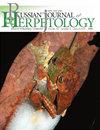Phylogeography of the Hong Kong Whipping Frog (Polypedates megacephalus) throughout Hainan Island, China
IF 0.9
4区 生物学
Q3 ZOOLOGY
引用次数: 0
Abstract
The Hong Kong Whipping Frog (Polypedates megacephalus) is widespread on Hainan Island and yet nothing is known about its history. To investigate this, we use sequences of a partial fragment of mitochondrial ND1 and its flanking region from 248 individuals taken from 30 localities. Analyses reveal low genetic diversity and commonly shared haplotypes. Montane areas exhibit a significantly greater genetic diversity than lowland areas (P 0.01). The origin of P. megacephalus on Hainan Island dates to 1.06 Ma in the Pleistocene. Population expansion events were associated with the transition from the last interglacial period to the last glacial maximum. The matrilineal history indicates dispersal from the montane to the lowland. Bidirectional dispersion occurs between northeastern and southwestern parts of the island. Low FCT values for the northeastern and the southwestern areas associate with rivers, whereas the highest values occur among two geographical groups. Thus, mountains and rivers appear to have effected dispersal. Pleistocene climatic cooling and the creation of a landbridge with mainland China owing to lowered sea levels best explains the occurrence of P. megacephalus on Hainan Island. The analyses provide insights into the effects of Pleistocene climatic fluctuations on an amphibian on Hainan Island.海南岛香港鞭蛙(大头足足科)的系统地理学
香港鞭蛙(Polypedates megacephalus)广泛分布于海南岛,但对其历史一无所知。为了研究这一点,我们使用了从30个地点采集的248个个体的线粒体ND1部分片段及其侧翼区域的序列。分析显示低遗传多样性和共同的单倍型。山地遗传多样性显著高于低地(P < 0.01)。海南岛巨头猿人的起源可追溯到更新世1.06 Ma。人口扩张事件与末次间冰期向末次盛冰期过渡有关。母系历史表明从山地向低地分散。双向扩散发生在岛的东北部和西南部。东北和西南地区的低FCT值与河流有关,而最高的FCT值出现在两个地理组中。因此,山脉和河流似乎起到了分散的作用。更新世气候变冷以及海平面下降导致的与中国大陆大陆桥的形成,最好地解释了巨头猪在海南岛的出现。这些分析为了解更新世气候波动对海南岛两栖动物的影响提供了新的见解。
本文章由计算机程序翻译,如有差异,请以英文原文为准。
求助全文
约1分钟内获得全文
求助全文
来源期刊

Russian Journal of Herpetology
ZOOLOGY-
CiteScore
1.70
自引率
0.00%
发文量
29
期刊介绍:
Russian Journal of Herpetology is an international multi-disciplinary journal devoted to herpetology. Russian Journal of Herpetology accepts original papers on ecology, behavior, conservation, systematics, evolutionary morphology, paleontology, physiology, cytology and genetics of amphibians and reptiles.
Types of Contributions:
-original papers
-invited or contributed reviews on specific topics
-short communications on topics of immediate interest, new methods and ideas in progress
-notices of meetings, symposia, and short courses
-book reviews
 求助内容:
求助内容: 应助结果提醒方式:
应助结果提醒方式:


